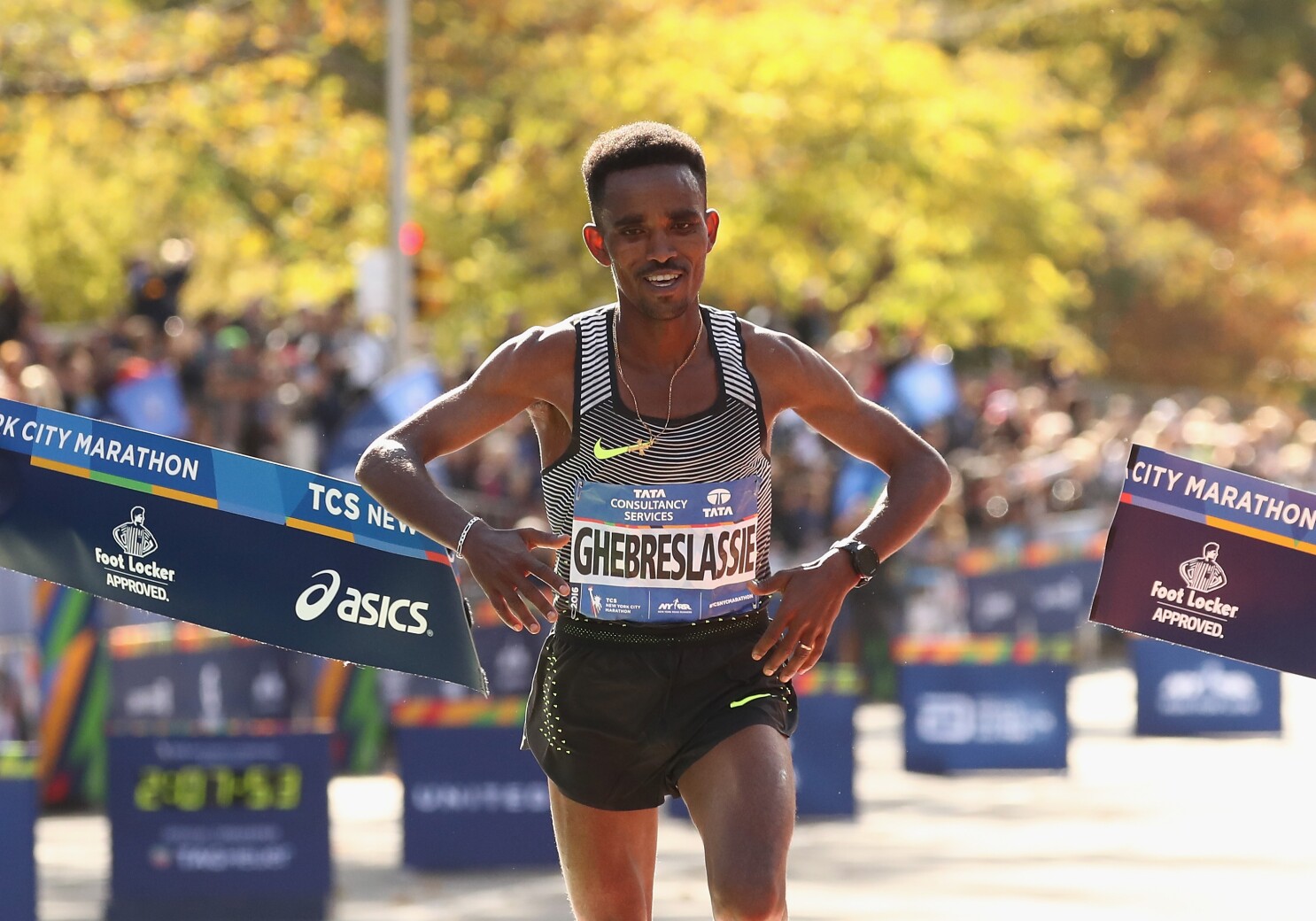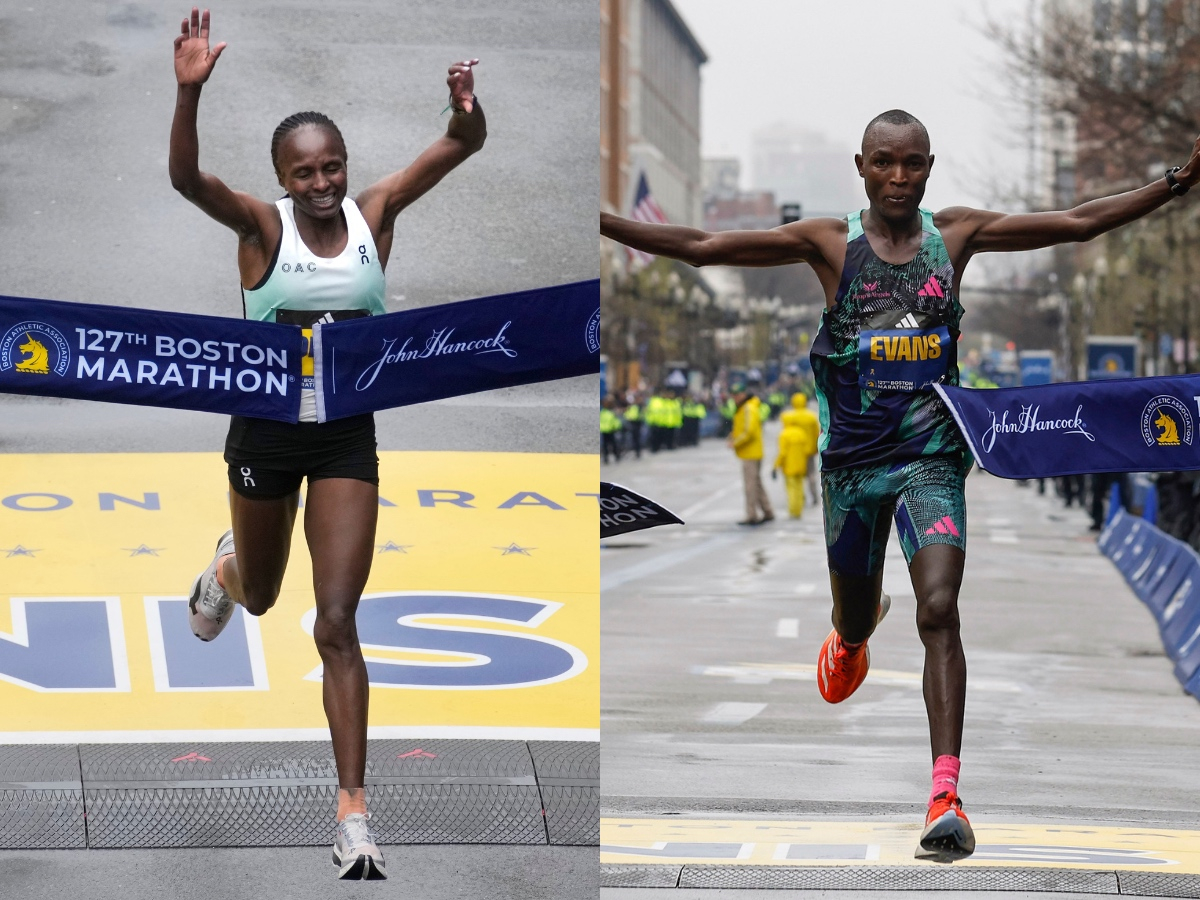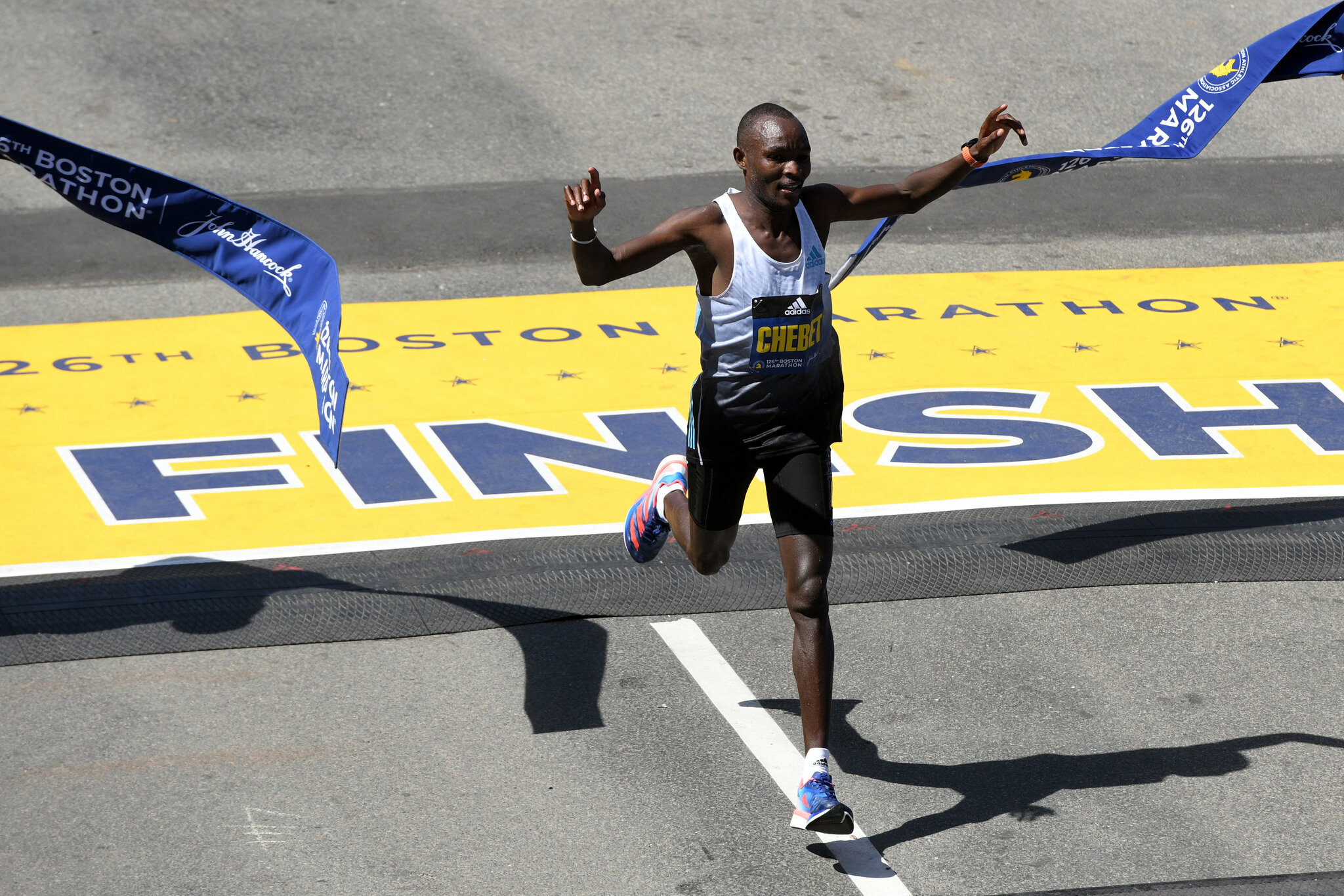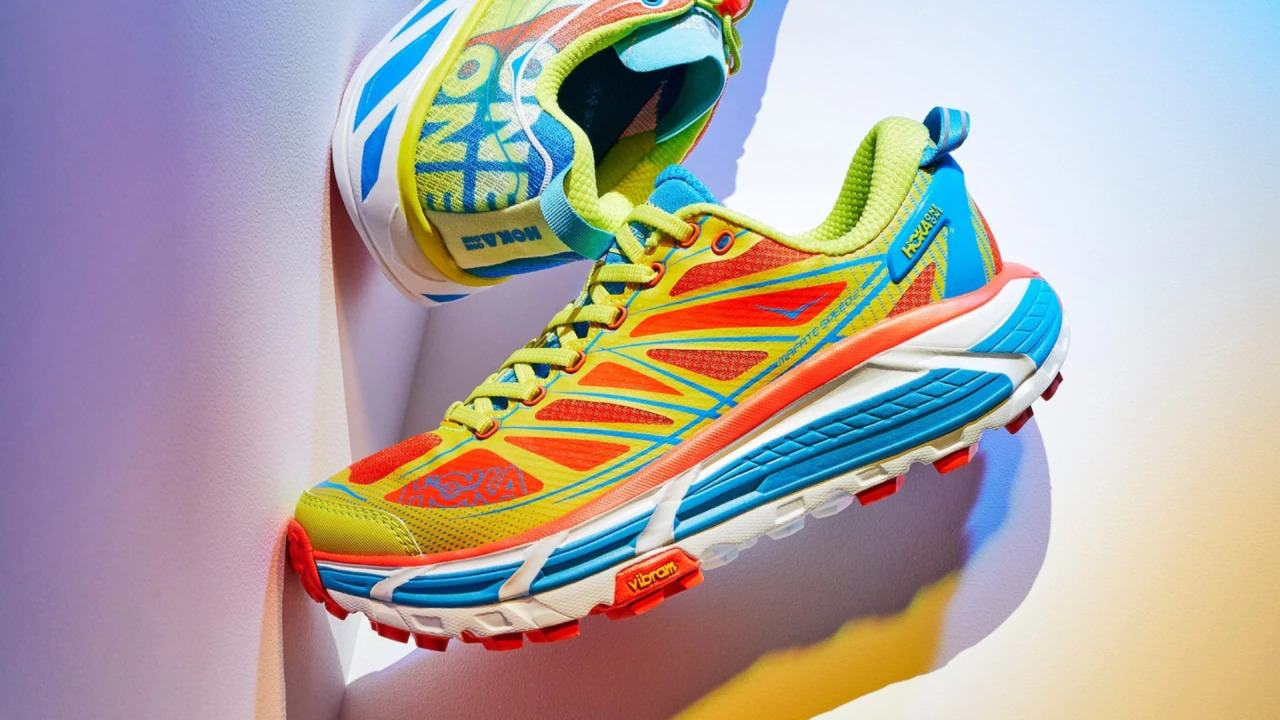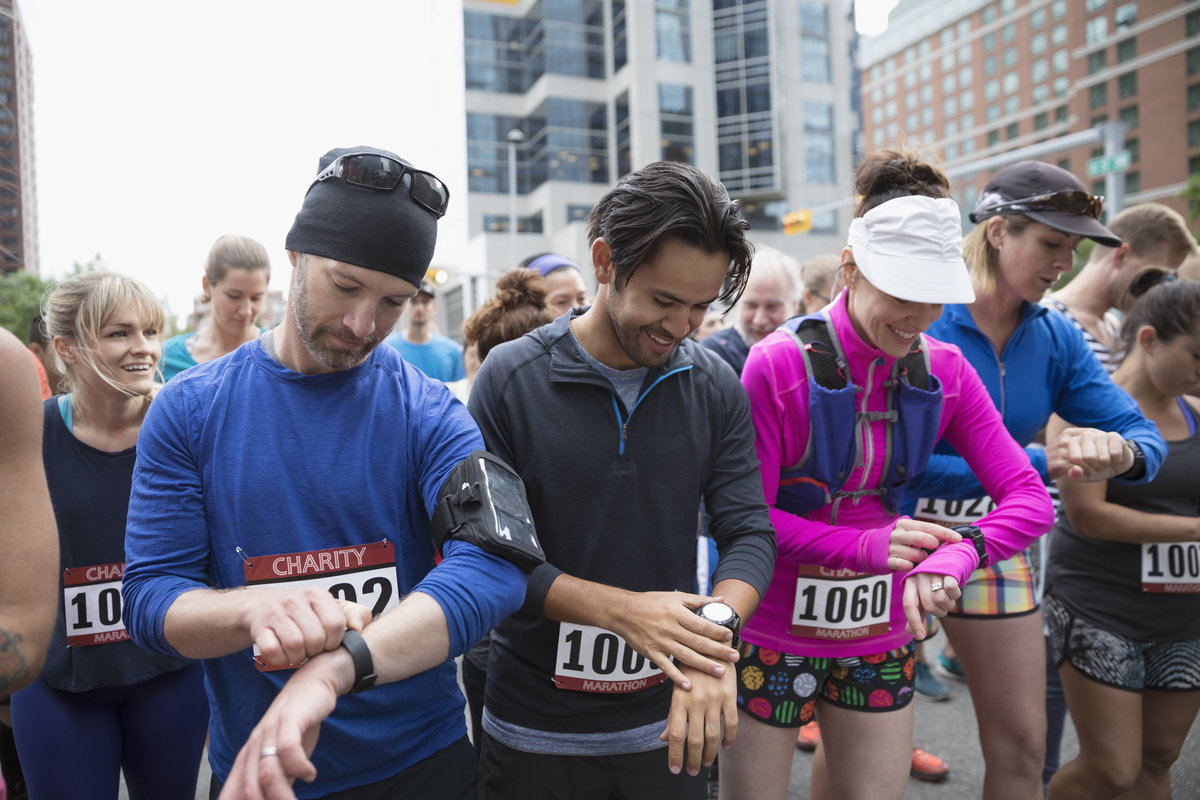

Featured
How Did The Marathon Get Its Name
Modified: January 2, 2024
Learn the fascinating history of how the marathon got its name in this featured article, exploring its ancient origins and enduring legacy.
The Origin of the Marathon
The marathon, a long-distance running event with a distance of 26.2 miles or 42.195 kilometers, has captivated athletes and intrigued spectators for centuries. But how did this enduring race get its name and become a symbol of endurance and human achievement?
The roots of the marathon trace back to ancient Greece, a civilization known for its love of sports and competitive athletics. The city-state of Athens, in particular, played a significant role in the development of the marathon.
Legend has it that the marathon takes its name from a Greek messenger named Pheidippides, who lived in the 5th century BCE. During the Battle of Marathon in 490 BCE, Pheidippides was dispatched to deliver a crucial message to Athens. The message was a proclamation of victory, as the outnumbered Athenian forces had successfully repelled the invading Persian army.
According to the story, Pheidippides ran the approximately 26-mile distance from the battlefield of Marathon to Athens without stopping. Exhausted, he delivered the message, exclaiming “Nike!” (meaning victory) before collapsing and succumbing to his fatigue.
While the legend of Pheidippides’ run serves as the inspiration for the modern marathon, there is debate among historians about its accuracy. Some argue that the story was a later invention to add dramatic flair to the historical events of the battle. Nonetheless, the tale has endured and captured the imaginations of athletes and historians alike.
The Battle of Marathon itself holds great significance in Greek history. It marked a decisive victory for the Athenians and halted the Persian invasion, thus ensuring the continued survival of Greek culture and democracy.
In commemoration of this momentous event and the alleged feat of Pheidippides, the first “Marathon” race was organized in the modern era. This took place during the inaugural Olympic Games of the modern era in Athens in 1896, marking the revival of the ancient Olympic tradition.
The race followed a course from the city of Marathon to the Panathenaic Stadium in Athens, echoing Pheidippides’ legendary run. Spyridon Louis, a Greek water-carrier, clinched the victory in the first modern marathon, further cementing its significance in athletic history.
Since then, the marathon has grown in popularity and become one of the most prestigious and challenging events in the world of sports. It has become a symbol of endurance, determination, and the pursuit of personal achievement. Today, marathons are held all around the globe, with participants from various backgrounds and abilities pushing their limits and striving to cross the finish line.
In the next section, we will explore the worldwide popularity of the marathon and its symbolism in greater detail.
The Legend of Pheidippides
The legend of Pheidippides, the Greek messenger who inspired the marathon, has become an integral part of the race’s folklore and mythology. This legendary figure has captivated the imagination of people worldwide and has come to symbolize the determination and perseverance required to conquer the marathon distance.
According to popular belief, Pheidippides played a crucial role in the Battle of Marathon, a historic confrontation between the Athenians and the Persians in 490 BCE. As the story goes, the Persian army had invaded Greece, and the Athenians, vastly outnumbered, needed reinforcements from their allies in Athens.
Pheidippides, a skilled long-distance runner, was chosen as the messenger to deliver the urgent plea for help. With great speed and endurance, he embarked on a harrowing journey that would forever be etched in history.
Setting off from the battlefield of Marathon, Pheidippides sprinted towards Athens, covering a distance of approximately 26 miles. It is said that he ran non-stop, motivated by a sense of duty and the importance of his mission.
As he approached the city, his energy depleted, he kept pushing forward, determined to reach his destination. Legend has it that upon his arrival, he gasped out the words “Nike!” (victory) before collapsing from exhaustion and, unfortunately, dying.
While historians debate the accuracy of this specific event, the story of Pheidippides’ run has become deeply ingrained in the marathon’s lore. It has been immortalized in literature and art and serves as a testament to the human will to overcome challenges and achieve greatness.
Pheidippides’ journey has inspired countless athletes and marathon runners, symbolizing the indomitable spirit required to conquer this grueling endurance race. His unwavering dedication and sacrifice have become emblematic of the marathon’s core values – perseverance, determination, and the pursuit of victory.
Today, marathons around the world pay homage to the legend of Pheidippides. Runners push themselves to their limits, drawing inspiration from the ancient Greek messenger who gave his all to complete his mission. The marathon has become a celebration of both physical endurance and the triumph of the human spirit.
While the story of Pheidippides may have originated from mythology or embellishment, the impact it has had on our understanding of the marathon cannot be denied. It serves as a reminder that within each runner lies the potential to achieve greatness, to overcome obstacles, and to reach new heights.
In the next section, we will delve into the historical significance of the Battle of Marathon and its connection to the marathon race.
The Battle of Marathon
The Battle of Marathon, fought in 490 BCE between the Athenians and the Persians, was a pivotal moment in ancient Greek history. This battle not only determined the fate of Greece but also played a significant role in shaping the origin and symbolism of the marathon race.
The Persian Empire, under the rule of King Darius I, sought to expand its territory and dominance, setting its sights on Greece. The Persian forces, led by Datis and Artaphernes, landed near the plains of Marathon, a short distance from Athens. The Athenians, aware of the imminent danger, mustered a force to defend their city and protect their way of life.
The Athenian army, composed of both citizen-soldiers and professional hoplites, awaited the Persian onslaught on the plains of Marathon. Despite being vastly outnumbered, with an estimated 10,000 Athenians against 25,000 to 30,000 Persians, the Athenians were determined to resist.
Under the leadership of the strategos (general) Miltiades, the Athenians formed a battle plan that capitalized on their superior armor and disciplined phalanx formation. The hoplites, armed with spears and shields, stood shoulder to shoulder, creating an impenetrable wall of defense.
As the Persian forces advanced, the Athenians held their ground, absorbing the attacks and inflicting heavy casualties upon their adversaries. The disciplined phalanx held strong and effectively pushed back the Persian flanks, causing confusion and chaos within their ranks.
Realizing their imminent defeat, the Persians retreated to their ships, seeking refuge and escape. The Athenians, in a bold move, launched a counterattack, pursuing the retreating enemy back to their ships. They managed to destroy a significant number of Persian vessels before they could set sail.
The Battle of Marathon was a resounding victory for the Athenians, securing their sovereignty and preserving the Greek way of life. It was a triumph of Greek strategy, discipline, and courage against the seemingly invincible Persian army.
The significance of the Battle of Marathon extends beyond the immediate military victory. It represented a turning point in Greek history, halting the Persian advance and preserving the independence of the Greek city-states. The battle inspired a sense of national pride among the Greeks, fostering a collective identity and unity against external threats.
It is within this historical context that the legend of Pheidippides and the marathon race emerged. The heroic feats of the Athenians, their endurance and sacrifice, became intertwined with the mythological story of Pheidippides’ run. The marathon race, then, became a symbol of honor and dedication, paying homage to those who fought and triumphed at Marathon.
In the next section, we will explore how Pheidippides and the Battle of Marathon are commemorated in the modern marathon race and its global popularity.
Commemorating Pheidippides
The legendary run of Pheidippides continues to be commemorated in the modern marathon race, paying homage to the historical significance and inspirational feats of the Greek messenger. From the ancient origins to the present day, the marathon race serves as a tribute to Pheidippides’ endurance and sacrifice.
Various forms of commemoration can be observed in marathons around the world. One of the most prominent ways is through the inclusion of statues or monuments of Pheidippides at the start or finish lines. These sculptures serve as a tangible reminder of the mythological origins of the race and the legendary figure who inspired it.
Furthermore, race organizers often incorporate elements of ancient Greek culture and history into the marathon events. From the design of medals and bib numbers to the names of race categories, Greek mythology and symbolism are prevalent, creating a connection between the modern race and its ancient roots.
Additionally, the route of many marathons seeks to replicate the famous journey undertaken by Pheidippides. Whether it’s starting or finishing in a historically significant location or following a path that resembles the distance he ran, these elements serve to create a sense of connection and tribute to the ancient tale.
Even the running community at large acknowledges the inspiration derived from Pheidippides and the Battle of Marathon. Many runners view the marathon as not just a physical challenge but also a mental and emotional journey, representing personal trials and the quest for victory.
The marathon race, then, encapsulates the spirit of Pheidippides and his unwavering determination. Participants push themselves to their limits, persevering through physical and mental challenges, just as the Greek messenger did to complete his mission.
Moreover, the commemoration of Pheidippides extends beyond the race itself, with various cultural and artistic works dedicated to celebrating his story. Paintings, sculptures, literature, and films continue to capture the essence of the legendary run and its impact on history and mythology.
In essence, the marathon race stands as a testament to the enduring legacy of Pheidippides and the Battle of Marathon. By incorporating the mythology, symbolism, and history associated with Pheidippides, the race becomes more than just a physical competition – it becomes a tribute to human resilience, determination, and the pursuit of victory.
In the next section, we will delve into the rise of the modern marathon and its worldwide popularity as a renowned sporting event.
The First Modern Marathon
The revival of the Olympic Games in the late 19th century brought about the establishment of the first modern marathon race, connecting the ancient tradition with the contemporary world. The inaugural modern marathon took place in Athens, Greece, in 1896, marking a significant milestone in the history of the race.
The organization of the marathon race was inspired by the ancient Greek tale of Pheidippides’ run from Marathon to Athens. The intention was to recreate and commemorate this legendary event as part of the newly revived Olympic Games.
The course of the first modern marathon followed the approximate route Pheidippides purportedly ran over two millennia ago. Starting in the town of Marathon, the runners embarked on a challenging journey, tracing the path that symbolized triumph and sacrifice.
Spectators eagerly awaited the arrival of the participating athletes in Athens’ Panathenaic Stadium, where the ancient Olympic Games were historically held. The atmosphere was electric as the runners, representing various nations, approached the finish line, fueled by both national pride and personal ambition.
This historic race took place on April 10, 1896, with seventeen brave individuals participating in the marathon. Greek water-carrier Spyridon Louis emerged as the victor, capturing the hearts of the Greek audience and etching his name in sporting history. His triumphant entry to the Panathenaic Stadium marked a moment of national pride and solidified the marathon as a symbol of Greek athletic prowess.
The first modern marathon captured the imagination of spectators and athletes worldwide, drawing attention to the significance of the race. It embodied the spirit of endurance, determination, and the pursuit of victory that resonated with people from various cultures and backgrounds.
Following the successful debut of the marathon in 1896, it quickly became a staple of the Olympic Games and spread to other international sporting events. The popularity of the marathon began to soar, captivating the interest of athletes seeking to test their physical and mental limits.
Throughout the years, advancements in transportation and technology enabled the marathon to expand its reach and attract a wider audience. With increased accessibility, the race became a platform for individuals to challenge themselves, promote health and fitness, and participate in a shared global experience.
The first modern marathon served as a catalyst for the proliferation of races around the world, inspiring athletes to embrace the enduring challenge of conquering the 26.2-mile distance. Today, marathons are held in cities across the globe, drawing participants from all walks of life to take part in this ultimate test of endurance.
The legacy of the first modern marathon lives on, reminding us not only of the ancient tale that sparked its inception but also of the universal human spirit that propels individuals to push their limits and achieve greatness.
In the next section, we will explore the worldwide popularity of the marathon and its enduring significance in the realm of sports.
The Marathon’s Worldwide Popularity
The marathon, since its revival in the modern era, has grown exponentially in popularity, becoming one of the most renowned and prestigious sporting events around the world. What started as a commemorative race in the Olympic Games has evolved into a global phenomenon, captivating athletes and spectators alike.
The allure of the marathon lies in the remarkable mental and physical challenge it presents. The 26.2-mile distance pushes individuals to their limits, requiring months of training, discipline, and dedication. Despite the demanding nature of the race, the marathon continues to attract a diverse range of participants, from elite athletes aiming for records to recreational runners seeking personal achievements.
One of the factors contributing to the marathon’s worldwide popularity is its inclusivity. Unlike some sporting events that require specialized skills or equipment, the marathon welcomes individuals of all ages and abilities. The concept of completing a marathon resonates with people from all walks of life, fostering a sense of unity and accomplishment amongst participants.
In addition, the marathon has become a catalyst for travel and tourism. Many cities organize marathons as a means to showcase their cultural heritage, scenic landscapes, and vibrant communities. Participants often plan their trips around marathons, providing a boost to local economies while also embracing the opportunity to explore new destinations.
The mass appeal of the marathon has also been facilitated by advances in communication and media technology. With live streaming, social media coverage, and televised broadcasts, viewers from different corners of the globe can witness the excitement and drama of marathons taking place in far-flung locations.
The marathon has also inspired numerous charitable initiatives, with participants often using the race as a platform to raise funds for various causes. From medical research to community development projects, the marathon has become a vehicle for individuals to make a positive impact on society.
Furthermore, the marathon serves as a source of inspiration and motivation for many individuals. Witnessing the determination and perseverance displayed by marathon runners fuels the belief that daunting challenges can be overcome with resilience and mental fortitude. The stories of triumph and personal achievement associated with the marathon resonate on a profound level, inspiring individuals to chase their own dreams and overcome obstacles.
As a result of its widespread popularity, marathons can be found in all corners of the globe. From the storied courses of Boston and New York City to the exotic routes of Tokyo and Athens, each marathon offers a distinctive experience, attracting participants from near and far.
The marathon’s worldwide popularity continues to grow, fueled by its rich history, the challenge it presents, and the sense of accomplishment it provides. This enduring appeal ensures that the marathon will remain a celebrated and revered event in the world of sports for generations to come.
In the next section, we will explore the symbolism and significance of the marathon in greater detail.
Symbolism and Significance of the Marathon
The marathon holds deep symbolism and significance, transcending its physical challenge to become a representation of human determination, resilience, and the pursuit of greatness. This enduring race carries profound meanings that resonate with participants and spectators alike.
One key symbolism of the marathon is endurance. The sheer distance of 26.2 miles pushes runners to their limits, testing their physical and mental stamina. Completing a marathon requires months of training, discipline, and perseverance. The marathon serves as a reminder that with dedication and commitment, great achievements are possible, even in the face of adversity.
Moreover, the marathon embodies the triumph of the human spirit. Every runner who crosses the finish line represents overcoming personal challenges, pushing past limits, and embracing the indomitable will to succeed. The marathon stands as a metaphor for transcending obstacles and achieving goals, inspiring individuals to reach their full potential in all aspects of life.
The marathon is also a symbol of unity and community. Participants from different backgrounds and cultures come together to celebrate a shared passion for running. The camaraderie among runners, the support from spectators, and the collective sense of accomplishment create a powerful sense of belonging and connection. The marathon emphasizes the strength of human bonds and the power of a supportive community.
Furthermore, the marathon carries historical and cultural significance. It is deeply rooted in ancient Greek mythology and the legendary tale of Pheidippides. The marathon pays tribute to the origins of the race, reminding us of the historical events that shaped the course of human civilization. It serves as a symbol of the enduring power of storytelling and the preservation of traditions.
Additionally, the marathon represents a journey of self-discovery and personal growth. Every participant embarks on a transformative experience, both physically and mentally. The race challenges individuals to confront their limits, face their fears, and discover newfound strength and resilience. It is a testament to the human capacity for growth and transformation.
Lastly, the marathon has become a platform for raising awareness and supporting charitable causes. Many runners use the race as an opportunity to champion organizations and initiatives that aim to make a positive impact on society. The marathon symbolizes the potential for individuals to contribute to the betterment of the world and support causes that are meaningful to them.
In summary, the marathon is more than just a race. It is a symbol of endurance, triumph, unity, and personal growth. Drawing on its historical roots, the marathon represents the timeless themes of human resilience, determination, and the pursuit of greatness. By embracing the challenges it presents, participants showcase the indomitable spirit of the human race and inspire others to strive for their own achievements.
In the next section, we will explore the evolution of marathon courses and how they have adapted over time.
Evolution of Marathon Courses
Over the years, the design and configuration of marathon courses have undergone significant changes, reflecting advancements in infrastructure, race organization, and athlete preferences. The evolution of marathon courses has played a crucial role in shaping the race experience for both runners and spectators.
In the early days of the marathon, courses often followed a point-to-point format, mirroring the historical route from Marathon to Athens. Participants would start in one location and finish in another, with the finish line typically located in a notable stadium or public gathering place. This format allowed for a direct connection to the mythological origins of the race and the historical significance of the marathon’s mythic roots.
However, as the popularity of marathons grew, organizers sought to create more spectator-friendly events and showcase iconic landmarks within host cities. This led to the development of looped courses, where participants would start and finish in the same location, completing multiple laps of a designated route.
Looped courses provided a more accessible viewing experience, allowing spectators to witness the runners passing by multiple times throughout the race. Additionally, organizers could strategically plan the course to showcase key landmarks, historic sites, and scenic areas, providing a unique and immersive experience for both athletes and spectators.
Another significant evolution in marathon courses has been the incorporation of mixed-terrain elements. While traditional marathons were predominantly run on paved roads, emerging trends have seen the inclusion of trails, parks, and even sand in some races. These varied terrains add an element of challenge and adventure to the race, offering a distinct experience for participants seeking a different kind of marathon challenge.
Furthermore, advancements in technology have allowed for more accurate measurements and markings of marathon courses. The establishment of international standards, such as those set by the International Association of Athletics Federations (IAAF), ensures that courses are precisely measured and certified, fostering fairness and consistency among races worldwide.
In recent years, there has also been a rise in themed and novelty marathon courses. Some races incorporate elements of entertainment, encouraging participants to dress up in costumes or run alongside popular characters. These events create a festive atmosphere and add a unique element of fun and excitement to the traditional marathon experience.
As marathons continue to thrive on a global scale, new course configurations and designs are constantly being explored to enhance the race experience. From point-to-point to looped courses, and from road surfaces to mixed terrains, marathon organizers strive to provide diverse and captivating running experiences for participants.
The evolution of marathon courses not only reflects the changing preferences and demands of both athletes and spectators but also highlights the adaptability and creativity of race organizers. With every innovation and modification, the marathon remains a dynamic and engaging event that captures the imagination and challenges the limits of human potential.
In the next section, we will explore some of the most famous marathons held around the world.
Famous Marathons Around the World
Marathons have become global events, attracting thousands of participants and capturing the attention of spectators worldwide. From the storied streets of major cities to the picturesque landscapes of scenic destinations, here are some of the most famous marathons held around the world:
1. Boston Marathon: Known as the oldest annual marathon and one of the most prestigious races, the Boston Marathon is steeped in history and tradition. Taking place on Patriot’s Day in April, this race attracts elite runners from all over the world and features a challenging course that winds its way through the hilly terrain of Boston, Massachusetts.
2. New York City Marathon: As one of the largest and most iconic marathons, the New York City Marathon draws participants from every corner of the globe. The race offers runners a unique opportunity to experience the vibrant energy of New York City as they traverse through all five boroughs, culminating in a triumphant finish in Central Park.
3. London Marathon: Held annually and often referred to as the most famous marathon in the world, the London Marathon combines historical landmarks, eclectic neighborhoods, and enthusiastic crowds along the course. With its iconic start line at Greenwich Park and finish line on The Mall, this race showcases the best of the English capital.
4. Tokyo Marathon: As one of the six World Marathon Majors, the Tokyo Marathon attracts a strong international field of elite runners. Taking place in February, this race offers a unique blend of traditional and modern elements, with participants traversing the bustling streets of Tokyo, passing iconic landmarks such as the Tokyo Tower and the Imperial Palace.
5. Berlin Marathon: Known for its flat and fast course, the Berlin Marathon has played host to many world records over the years. Held in September, this race takes participants through the vibrant streets of Berlin, passing landmarks like the Brandenburg Gate and the Berlin Wall. The atmosphere and organization of the event make it a favorite among both professional and recreational runners.
6. Chicago Marathon: Held in October, the Chicago Marathon is one of the most popular races in the United States. Known for its flat and fast course, this race takes participants through the diverse neighborhoods of Chicago, offering stunning views of Lake Michigan and iconic city landmarks such as Grant Park and Buckingham Fountain.
7. Great Wall Marathon: Combining athleticism with breathtaking scenery, the Great Wall Marathon in China is a truly unique race. Participants tackle steep climbs and descents as they traverse sections of the iconic Great Wall, providing a challenging and awe-inspiring experience.
These are just a few examples of the many marathons held worldwide. Each race offers its own distinct character, showcasing the culture, landmarks, and landscapes of their host cities. Whether it’s the historic grandeur of Boston, the urban splendor of New York City, or the international allure of Tokyo, these marathons continue to captivate runners and spectators, embodying the spirit of the marathon on a global stage.
In the next section, we will explore the training and preparation required for a marathon.
Training for a Marathon
Preparing for a marathon requires careful planning, dedication, and a systematic training approach. Whether you are an experienced runner or a beginner, here are some essential elements to consider when training for a marathon:
1. Establish a Training Plan: Start by creating a structured training plan that suits your fitness level and goals. Gradually increase your weekly mileage and incorporate long runs, speed workouts, and recovery days. Consistency is key, and a well-structured plan will help you build endurance and improve your overall fitness.
2. Gradual Mileage Build-Up: Increase your mileage gradually to avoid overuse injuries. Aim for a weekly increase of 10-15% in mileage and include recovery weeks to allow for proper rest and adaptation. Listen to your body, be mindful of any pain or discomfort, and adjust your training accordingly.
3. Long Runs: Long runs are a central component of marathon training. These runs simulate the race distance and help build endurance. Start with shorter distances and gradually extend the length of your long runs until you are comfortable running close to the full marathon distance in your training.
4. Speed Workouts: Incorporate speed workouts such as intervals, tempo runs, and fartleks. These sessions improve your aerobic capacity, running economy, and speed. Include a mix of shorter, faster intervals and longer, sustained tempo runs to challenge different energy systems and improve overall race pace.
5. Strength Training and Cross-Training: Don’t neglect strength training and cross-training activities as they help enhance overall fitness, prevent injury, and improve running efficiency. Include exercises that target your core, legs, and upper body, as well as low-impact activities like swimming or cycling to supplement your running.
6. Recovery and Rest: Adequate recovery is crucial to avoid burnout and injuries. Incorporate rest days into your training schedule to allow your body to repair and adapt. Focus on quality sleep, proper nutrition, hydration, and active recovery methods such as foam rolling, stretching, and regular massages.
7. Nutrition and Hydration: Proper fueling is essential during marathon training. Prioritize a well-balanced diet that includes carbohydrates, proteins, healthy fats, and ample fruits and vegetables. Experiment with different pre-run and mid-run fueling strategies to find what works best for you. Stay hydrated throughout your training, especially during long runs and hot weather.
8. Mental Preparation: Marathon training is not just physical; it also requires mental strength and resilience. Develop mental strategies such as visualization, positive self-talk, and goal setting to overcome challenges during training and on race day. Surround yourself with a support network of fellow runners, coaches, and friends who can provide motivation and encouragement.
Remember, every runner’s journey is unique, and it is important to listen to your body, adapt your training as needed, and set realistic goals. Building up gradually, focusing on consistency, and taking care of your body through rest and recovery will help you reach the starting line feeling strong and prepared for the marathon challenge ahead.
In the final section, we will reflect on the significance of marathons and their enduring appeal in the realm of sports.
Conclusion
The marathon, with its rich history, enduring symbolism, and global popularity, stands as a testament to the resilience, determination, and human spirit. From its mythical origins in ancient Greece to the modern marathon races held around the world, the marathon has captured the imagination of athletes and spectators alike.
The marathon’s origins can be traced back to the legendary run of Pheidippides and the Battle of Marathon. These tales have become deeply ingrained in the marathon’s folklore, inspiring runners to embrace the challenge and conquer the 26.2-mile distance. The marathon is a celebration of endurance, triumph, and personal growth.
Throughout the years, marathon courses have evolved, incorporating historical landmarks, varied terrains, and looped routes to create memorable experiences for runners and spectators. From the renowned streets of Boston and New York City to the international allure of Tokyo and the scenic beauty of Berlin, marathon courses offer a unique glimpse into the culture and landscapes of host cities.
The marathon’s worldwide popularity continues to soar, drawing participants from diverse backgrounds and inspiring individuals to reach their full potential. It has become a platform for raising awareness and supporting charitable causes, showcasing the power of the marathon to make a positive impact on society.
Training for a marathon requires dedication, discipline, and careful planning. By gradually increasing mileage, incorporating long runs, speed workouts, and cross-training activities, runners can prepare both their bodies and minds for the challenges that lie ahead. Proper nutrition, hydration, rest, and mental strategies are critical components in ensuring a successful marathon journey.
In summary, the marathon represents more than just a race. It embodies endurance, triumph, unity, personal growth, and the relentless pursuit of greatness. From its historical origins to its global reach, the marathon instills a sense of awe, inspiration, and camaraderie among participants and spectators alike.
As we continue to witness the excitement and dedication surrounding marathons, we are reminded of the indomitable spirit of the human race. The marathon serves as a reminder that with perseverance and determination, we can conquer any challenge, push our limits, and achieve our goals. So, whether you are a seasoned marathoner or contemplating your first race, let the marathon inspire you to embrace the journey of self-discovery, resilience, and extraordinary accomplishment.
